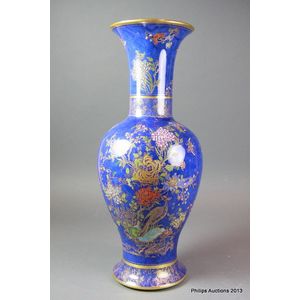Doulton Lambeth Neoclassical Vase
You must be a subscriber, and be logged in to view price and dealer details.
Subscribe Now to view actual auction price for this item
When you subscribe, you have the option of setting the currency in which to display prices to $Au, $US, $NZ or Stg.
- Anthemion - An anthemion is a classical decorative design element based on the acanthus flower that consists of a central circular or oval motif surrounded by radiating petals or leaves. It is often used as a border or frieze in architecture, furniture, and other decorative arts. The anthemion is derived from the palmette, a motif that was popular in ancient Greek and Roman art and architecture. It is often associated with the classical world and with Neoclassical style, and it is often used to add a sense of grandeur and formality to a design. The anthemion is also known as a honeysuckle or honeysuckle ornament. It continues to be used in a variety of contexts today, and it is often admired for its elegant and decorative qualities.
- Oviform /ovoid - The outline loosely resembling the shape of an egg.
- Salt Glazed - Salt glazing involves throwing salt into the kiln when it is at its highest temperature, usually around 2,300 to 2,400 degrees Fahrenheit (1,260 to 1,320 degrees Celsius). The salt vaporizes and forms a glaze on the surface of the pottery, creating a range of effects depending on how the salt is applied and the firing conditions. This glazing method was first developed in Germany in the 15th century and quickly became popular throughout Europe and North America. It was particularly popular for making stoneware pottery, such as jugs, crocks, and other utilitarian objects.
Salt glazes can produce a range of colors, including gray, brown, blue, and even pink or purple in some cases. The texture of the glaze is typically rough and pebbled, with a matte or satin finish. The process of salt glazing can be unpredictable, with variations in temperature and salt application leading to subtle variations in the finished product.
Salt glazing is still used by potters and ceramic artists although it is less common than it was in the past. - Circa - A Latin term meaning 'about', often used in the antique trade to give an approximate date for the piece, usually considered to be five years on either side of the circa year. Thus, circa 1900 means the piece was made about 1900, probably between 1895 and 1905. The expression is sometimes abbreviated to c.1900.
This item has been included into following indexes:
-
Royal Doulton (England), item types
- Lambeth Ware, vases 268
- ovoid and baluster shaped vases 1,572
- vases, other 780
Visually similar items

An impressive tall Carlton Ware vase, circa 1916, baluster shaped with a columnar flared neck, superbly decorated with sprays of flowers in gilt and enamels in 'Rockery and Pheasant' pattern 2071 on a mottled blue ground, similarly decorated to neck and wi

A Doulton Burslem earthenware pedestal vase, circa 1890, artist's mark as for Alice hall (nee Shelly), a slender baluster vase with a trumpet neck, with spiral moulding, patterned bands and allover floral filigree to the neck and foot in muted gold, a cent

A Chinese export vase, on an inset revolving stand. Lotus decoration on yellow ground, of baluster form and bulbous neck, the stand painted with peonies and daisies. Vase 38 cm high.

A striking Royal Worcester 'Shot enamel' vase. 1897. Of tapering ovoid form with a narrow trumpet neck and a conforming pedestal both moulded with neo-classical elements, lappets and an extended pendant collar in orange and green 'Shot' colours in low reli
